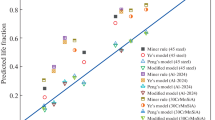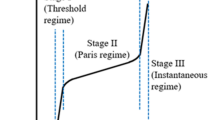Abstract
This study is based on continuum damage mechanics and constructs an improved macro–micro-two-scale model to predict the fatigue life of engineering metallic materials subjected to variable amplitude loading. To account quantitatively for the fatigue damage retarding effect of higher load on lower ones in a loading sequence, the cyclic plastic response curve of microscopic weak inclusion is independently designed. Meanwhile, an improved two-scale fatigue damage model in rate form is proposed by introducing a new exponent function acted on the equivalent plastic strain term in the model for taking account of fatigue mean stress effect under variable amplitude loading. The parameters of the two-scale fatigue damage model are identified through an inverse approach based on fatigue test results under constant amplitude loading. The predictive accuracy of the proposed model is validated by fatigue test data of Al 2024-T3 standard coupon and plate with a hole under different variable amplitude loading.












Similar content being viewed by others
References
Huang, W., Sridhar, N.: Fatigue failure risk assessment for a maintained Stiffener-Frame welded structure with multiple site cracks. Int. J. Appl. Mech. 8(1), 1650024 (2016)
Hull, D., Bacon, D.J.: Introduction to dislocations. Butterworth-Heinemann, Oxford (2011)
Gupta, A., Sun, W., Bennett, C.J.: Simulation of fatigue small crack growth in additive manufactured Ti-6Al-4V material. Continuum Mech. Thermodyn. (2020). https://doi.org/10.1007/s00161-020-00878-0
Bandara, C.S., Siriwardane, S.C., Dissanayake, U.I., et al.: Developing a full range S-N curve and estimating cumulative fatigue damage of steel elements. Comput. Mater. Sci. 96, 96–101 (2015)
Todinov, M.T.: Necessary and sufficient condition for additivity in the sense of Palmgren-Miner rule. Comput. Mater. Sci. 21, 101–110 (2001)
Vasudevan, A.K., Sadananda, K., Iyyer, N.: Fatigue damage analysis: issues and challenges. Int. J. Fatigue 82, 120–133 (2016)
Lemaitre, J., Desmorat, R.: Engineering Damage Mechanics. Springer, Berlin (2005)
Elshelby, J.D.: The determination of the elastic field of an ellipsoidal inclusion and related problems. Proc. R. Soc. Lond. A241, 376–396 (1957)
Hill, R.: Continuum micro-mechanics of elastoplastic polycrystals. J. Mech. Phys. Solids 13, 89–101 (1965)
Hill, R.: On constitutive macro-variables for heterogeneous solids at finite strain. Proc. R. Soc. Lond. A241, 131–147 (1972)
Iwakuma, T., Nemat-Nasser, S.: Finite elastic-plastic deformation of poly-crystalline metals. Proc. R. Soc. Lond. A394, 87–119 (1984)
Kröner, E.: On the plastic deformation of polycrystals. Acta Metallurgica 9, 155–161 (1961)
Berveiller, M., Zaoui, A.: Self-consistent schemes for heterogeneous solid mechanics. In Comportement Rhéologique et Structure des Matériaux, CR 15è coll. GFR, Paris (1980)
Pierard, O., Gonzalez, C., Segurado, J., et al.: Micromechanics of elasto-plastic materials reinforced with ellipsoidal inclusions. Int. J. Solids Struct. 44, 6945–6962 (2007)
Lemaitre, J.: A Course on Damage Mechanics. Springer, Berlin (1992)
Lemaitre, J., Desmorat, R., Sauzay, M.: Anisotropic damage law of evolution. J. Mech. Theor. Appl. 19, 187–208 (2000)
Lemaitre, J., Doghri, I.: Damage 90: a post processor for crack initiation. Comput. Method Appl. Mech. Eng. 115, 197–232 (1994)
Lemaitre, J., Sermage, J.P., Desmorat, R.: A two scale damage concept applied to fatigue. Int. J. Fract. 97, 67–81 (1999)
Laiarinandrasana, L., Morgeneyer, T.F., Cheng, Y., et al.: Microstructural observations supporting thermography measurements for short glass fibre thermoplastic composites under fatigue loading. Continuum Mech. Thermodyn. 32, 451–469 (2020). https://doi.org/10.1007/s00161-019-00748-4
Sun, B., Xu, Y.L., Li, Z.: Multi-scale fatigue model and image-based simulation of collective short cracks evolution process. Comput. Mater. Sci. 117, 24–32 (2016)
Lautrou, N., Thevenet, D., Cognard, J.Y.: Fatigue crack initiation life estimation in a steel welded joint by the use of a two-scale damage model. Fatigue Fract. Eng. Mater. Struct. 32(5), 403–417 (2009)
Qian, C., Westphal, T., Nijssen, R.P.L.: Micro-mechanical fatigue modelling of unidirectional glass fibre reinforced polymer composites. Comput. Mater. Sci. 69(1), 62–72 (2013)
Lemaitre, J., Sermage, J.P.: One damage law for different mechanisms. Comput. Mech. 20, 84–88 (1997)
Eggertsen, P., Mattiasson, K.: On the identification of kinematic hardening material parameters for accurate springback predictions. Int. J. Mater Form 4, 103–120 (2011)
Bathe, K.J., Montans, F.J.: On modeling mixed hardening in computational plasticity. Comput. Strut. 82(6), 535–539 (2004)
Nijssen, R.P.L., Van Delft, D.R.V., Van Wingerde, A.M.: Alternative fatigue lifetime prediction formulations for variable-amplitude loading. J. Sol. Energy Eng. 124(4), 396–403 (2002)
Burger, M., Wolfram, M.: Numerical approximation of an SQP-type method for parameter identification. SIAM J. Numer. Anal. 40, 1775–1797 (2002)
Miner, M.A.: Cumulative damage in fatigue. J. Appl. Mech. 14, A159–164 (1945)
Acknowledgements
This work is supported by the National Natural Science Foundation of China (51375386).
Author information
Authors and Affiliations
Corresponding author
Additional information
Communicated by Andreas Öchsner.
Publisher's Note
Springer Nature remains neutral with regard to jurisdictional claims in published maps and institutional affiliations.
Rights and permissions
About this article
Cite this article
Liu, X.R., Sun, Q. An improved macro–micro-two-scale model to predict high-cycle fatigue life under variable amplitude loading. Continuum Mech. Thermodyn. 33, 803–816 (2021). https://doi.org/10.1007/s00161-020-00958-1
Received:
Accepted:
Published:
Issue Date:
DOI: https://doi.org/10.1007/s00161-020-00958-1




